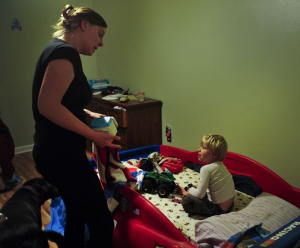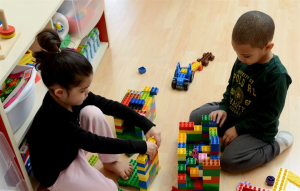Structure (with Flexibility): Routines, Rules, Directions
Children (and most people of all ages) thrive in flexibly-structured environments. For children, the sense of knowing what to expect typically elicits feelings of safety and security. Caregivers can help children reduce feelings of chaos by providing flexible, but consistent:
- Routines,
- Rules, and
- Concrete, explicit directions with easy-to-understand expectations.
Rules and Routines

In order to maintain consistent routines (e.g., bedtimes, traditions) and rules (e.g., not eating food in certain areas of the house, curfews, wearing a helmet while riding a bicycle) it is important to facilitate and adhere to them as much as possible. Expectations should be developmentally-appropriate and communicated in a manner that can be easily understood. [1]
For instance, perhaps family meals are at 6:30 p.m. because this is the time that everyone gets home from work and school activities. This expectation and all moderations should be communicated with all members on a daily basis but also remain flexible. Exceptions that may change a family mealtime might include attending a school-related activity or having a large family gathering every Sunday at 1:30 p.m.
Video Example
Watch this YouTube video about creating structure.
Directions
Specific, warm, concrete, understandable directions and expectations can improve behaviors, prevent dangerous circumstances, reduce caregivers’ frustrations, and foster children’s learning of appropriate behaviors. It is most effective to tell children exactly what behaviors you desire.
Examples
- “Please use your walking feet while we are in the library,” is more detailed than saying, “Stop that!”
- Another example is, “We must hold hands in the parking lot to avoid getting hit by a car,” instead of “Hey, come back here!” as the child runs through the parking lot.
- Visit this website from the CDC to learn how to give good directions.
- Watch this YouTube video to learn how to provide quality directions.
Consistency, consistency, consistency with warmth

Research shows that children’s abilities to anticipate change, use appropriate behaviors, and develop independence are fostered by warm, safe, stable, nurturing, caring, compassionate caregiving on a consistent basis! This means that routines, rules, directions, expectations, and consequences should be responded to or applied every time in a nurturing, warm, consistent manner.[2] [3]
Key Takeaways
- Providing a warm, close, nurturing, and openly-communicative environment with consistent routines, directions, and rules with reasonable flexibility are key for eliciting feelings of predictability and security. [4]
- It is not too late to learn, teach, and reinforce these skills for caregivers and youth. However, it may take time and practice to elicit changes.
- American Academy of Pediatrics. (2007, June 1). The importance of family routines. Retrieved from https://www.healthychildren.org/English/family-life/family-dynamics/Pages/The-Importance-of-Family-Routines.aspx ↵
- Centers for Disease Control and Prevention. (2019). Building structure. Retrieved from https://www.cdc.gov/parents/essentials/structure/building.html ↵
- Gillespie, L. (2015). Rocking and Rolling – It takes two: The role of co-regulation in building self-regulation skills. Young Children 70(3). 94-96. https://www.naeyc.org/resources/pubs/yc/jul2015/rocking-rolling ↵
- American Psychological Association. (2014). Resilience booster: Parent tip tool. Retrieved from https://www.apa.org/topics/parenting/resilience-tip-tool ↵

